Great content takes time and effort. The good news is that you don’t have to give it away for free or depend on unpredictable ad clicks.
With a pay-per-view site, you can charge viewers directly for your work and build a steady income stream you control.
We’ve seen many WordPress users succeed with this method. In fact, a friend of one of our team members built a pay-per-view platform with MemberPress, and he now earns more than he did at his previous job.
In this guide, we’ll show you how to create your own pay-per-view site in WordPress.
You’ll learn which plugins to use, how to set up payments, and simple strategies that turn visitors into paying customers.

Here is a list of all the topics we will be covering.
You can use the links below to jump to the section of your choice:
- How Do Pay-Per-View Websites Work?
- What Do You Need to Build a Pay-Per-View Website With WordPress?
- Creating a Pay-Per-View Site in WordPress With MemberPress
- Creating Membership Levels
- Restricting Content to Membership Plans
- Creating a Pricing Page
- Redirecting Users to the Pricing and Plans Page
- Taking Your Pay-Per-View Website to the Next Level
- Frequently Asked Questions About Pay-Per-View Websites
How Do Pay-Per-View Websites Work?
A pay-per-view website is one where users pay to access your content directly. Unlike ad-based or affiliate models, you keep most of your earnings and don’t rely on third parties.
For example, YouTube allows users to rent movies or shows and watch them within a certain period. This is a classic pay-per-view model: viewers pay for direct access without going through other platforms.
However, there are different types of pay-per-view models you can create:
- Digital downloads – Sell files like videos, PDFs, or courses directly in WordPress.
- Time-based passes – Offer daily, weekly, or yearly subscriptions that give users unlimited access.
- Drip content plans – Release content gradually over time instead of all at once.
In this guide, we’ll focus on time-based passes, which give users access to all your premium content for a specific period—like a day, a month, or a year.
This model is popular because it’s flexible and works well for WordPress creators.
What Do You Need to Build a Pay-Per-View Website With WordPress?
To create a pay-per-view website with WordPress, you need three main things:
- Hosting – A place to store your website files.
- Domain – Your website address (like
www.wpbeginner.com). - MemberPress – A premium plugin to create a pay-per-view site
Normally, a domain costs $14.99 per year, and hosting starts at $7.99 per month, which can be expensive when you’re just starting.
Luckily, Bluehost offers WPBeginner users a free domain and hosting starting at $2.99 per month, with WordPress automatically installed.

We also recommend Hostinger, which offers a generous discount and a free domain name to WPBeginner readers.
Once your hosting is purchased and WordPress is installed, your website is ready for the next step: installing MemberPress to start building a pay-per-view site.
Creating a Pay-Per-View Site in WordPress With MemberPress
The easiest way to create a pay-per-view site is by using the MemberPress plugin. It is the best WordPress membership plugin that allows you to restrict content and sell pay-per-view subscriptions.
At WPBeginner, we’ve used it to create a free video membership site for our online courses. For more information, take a look at our detailed MemberPress review.
First, you need to sign up for an account on the MemberPress website. Just click on the ‘Get MemberPress for WordPress’ button and follow the instructions to sign up for an account.

Next, you need to install and activate the MemberPress plugin. For more details, see our step-by-step guide on how to install a WordPress plugin.
Upon activation, go to the MemberPress » Settings page and then enter your license key.
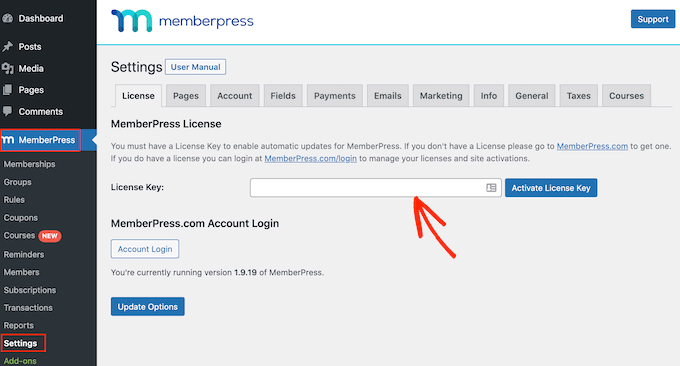
You’ll find this information in your account on the MemberPress website. It’s also in the email you got when you purchased MemberPress.
After entering this information, click on ‘Activate License Key.’
Next, you need to set up at least one payment gateway to accept credit card payments on the pay-per-view site easily.
MemberPress supports PayPal, Stripe, and Authorize.net. To add one of these payment gateways to your site, click the ‘Payments’ tab and then select ‘Add Payment Method.’
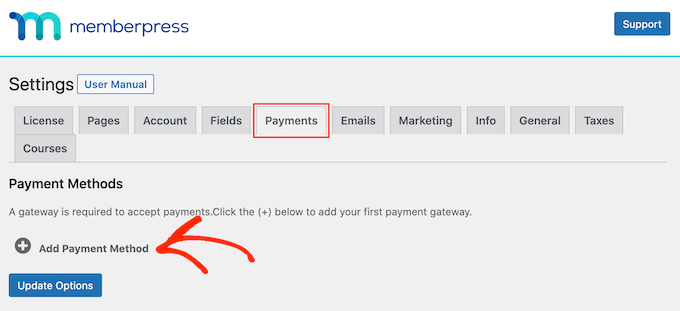
After that, open the ‘Gateway’ dropdown and select the gateway you want to use.
MemberPress will now show all the settings you need to configure before you can use this payment gateway. Each gateway has different settings. For example, in the following image, we are adding PayPal payments to WordPress.
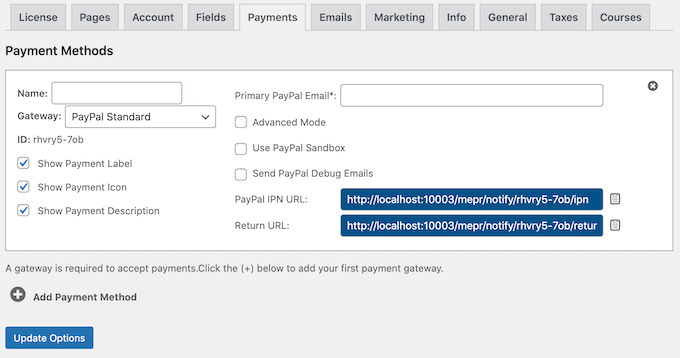
Once you’ve configured the gateway, click ‘Update Options’ to save your settings.
You can often get more customers by allowing users to choose a payment method. If you do want to add multiple gateways to your pay-per-view site, then simply click ‘Add Payment Method’ and repeat the process described above.
Creating Membership Levels
Now, you are ready to create membership levels for your pay-per-view site by going to MemberPress » Memberships.
Here, click on ‘Add New.’
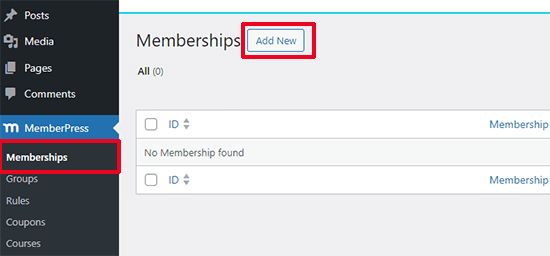
You can now type in a title for this membership plan and add an optional description in the post editor.
Next, you need to set the pricing and expiration in the ‘Membership Terms’ box.
For example, you might charge a one-time fee for lifetime access or set up a recurring monthly subscription. If you choose ‘Recurring,’ then you can use the settings to charge members on a weekly, monthly, quarterly, or annual basis.
In the following image, we are charging $100 every six months.
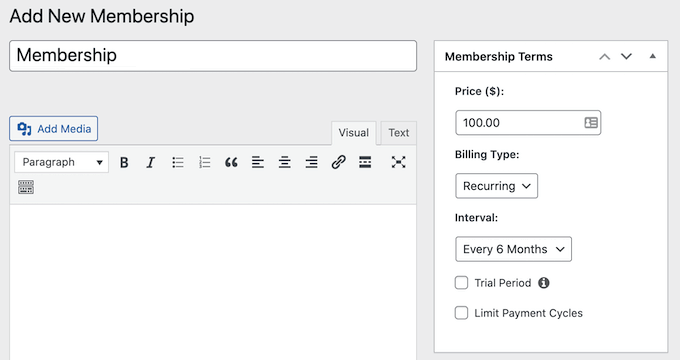
By accepting recurring payments in WordPress, you can automate the billing process. This can save you a ton of time and generally leads to fewer payment delays and errors. It also means you don’t have to send invoices manually.
So, which one should you choose? A one-time payment is often best for a single, large product, like an online course or an ebook.
On the other hand, a recurring subscription works great if you plan to add new content regularly, like weekly videos, monthly articles, or new resources for your members.
If you select ‘One-Time,’ then you can choose ‘Lifetime’ or set an expiration date, which can either be a calendar date or a length of time, such as one month since the person purchased their membership.
In the following image, we’re creating a plan that expires in 24 hours. We’ve also checked the ‘Allow early renewals’ option so users can renew their membership before it expires.
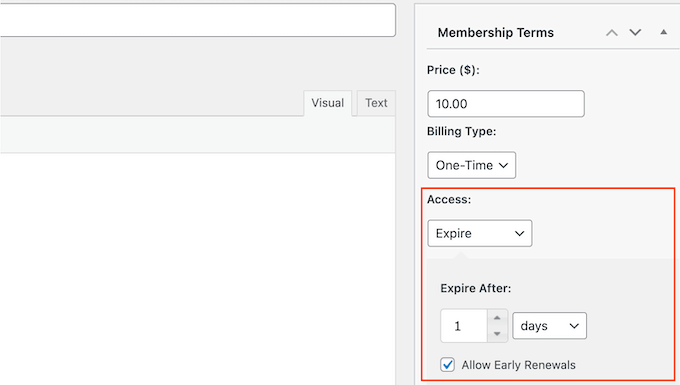
After choosing a billing type, you might need to configure some extra settings. Most of these settings are fairly straightforward, so you can look them over and make any changes you like.
When ready, scroll down to the ‘Membership Options’ box below the post editor. This is where you can set up different options for this membership plan.

The default membership options will work for most pay-per-view WordPress websites, but you can make any changes.
With that done, click on the ‘Price Box’ tab and type in all the information you want to show on your website. This includes the plan’s benefits, which will help convince people to buy a pay-per-view subscription.
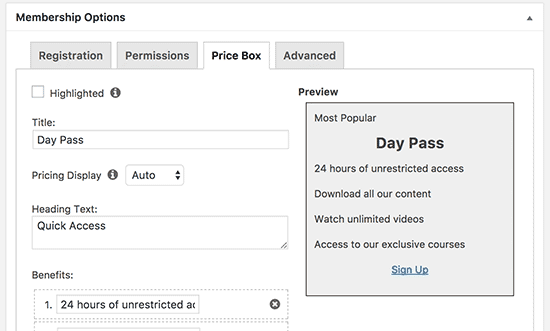
When you are happy with the plan’s configuration, click on ‘Publish’ to make it live.
You can create multiple membership plans with different settings, such as monthly or yearly passes. To create more membership levels, simply follow the same process described above.
Restricting Content to Membership Plans
Once you’ve done that, you’re ready to restrict content so that only people with a valid membership can access it.
You do this by creating membership rules, so go to the MemberPress » Rules page and click on the ‘Add New’ button.
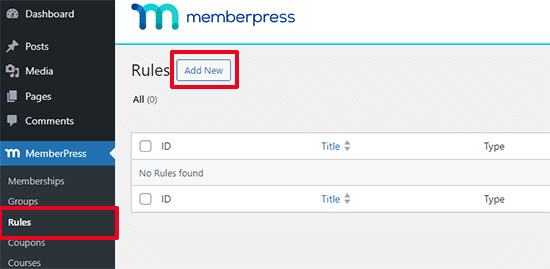
You can create generic rules that apply to all content or very specific rules for individual items on your website.
For example, you can restrict all content in a particular category, tag, or lock a specific post or URL.
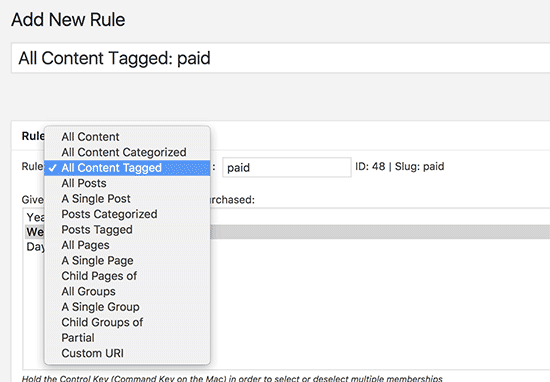
For example, imagine you run a fitness website. You could restrict access to all your special videos by giving them a ‘Premium-Workouts’ tag.
If you need help, please see our step-by-step guide on adding categories and tags for WordPress pages.
To restrict access to a specific tag, open the ‘Protected Content’ dropdown and choose ‘All Content Tagged.’ Then, type in the tag that you want to use.
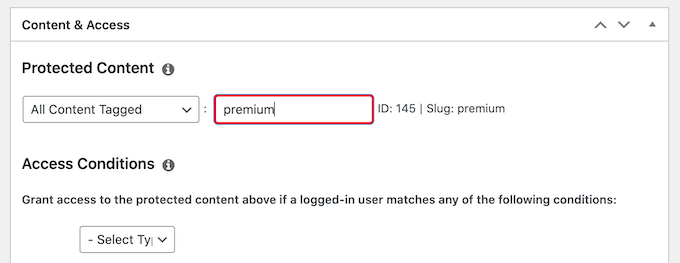
Below the rules editor, you’ll see the content drip and expiration options.
Drip content allows you to gradually release content to users.

For more information, please see our guide on how to add automatic drip content to your WordPress site.
Optionally, you can set an expiration date by checking the ‘Enable Expiration’ box.
In this way, you can use FOMO to increase conversions since the content is only available for a limited time. It can also encourage more people to buy memberships so they don’t miss out on the time-restricted content.

Once you are done, scroll to the top of the page and click on the ‘Save Rule’ button. You can repeat these steps to create as many rules as you want.
Creating a Pricing Page
Next, you’ll want to create a pricing page so your visitors can see and compare your membership plans. In MemberPress, you do this using a feature called ‘Groups’.
To get started, go to the MemberPress » Groups page and click the ‘Add New’ button.
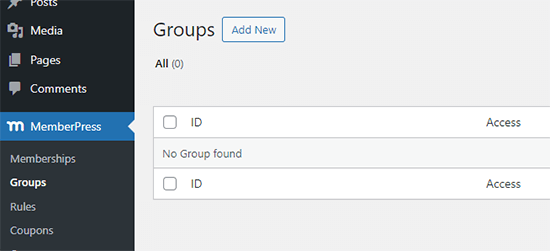
First, you need to type in a title for the group plan page, which will be visible to visitors.
After that, scroll down to the’ Group Options’ box. You can add the memberships you want to display on the pricing page.
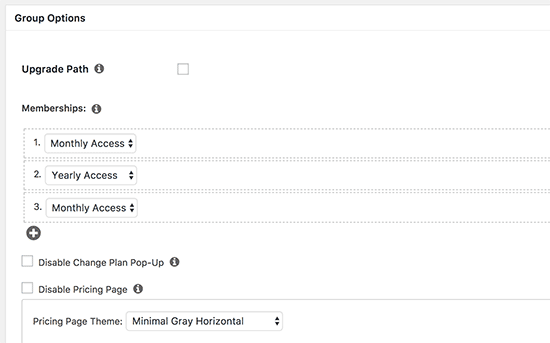
You can also select a theme for the pricing table. MemberPress comes with a few ready-made designs to choose from.
When you are happy with how the page is set up, click the ‘Publish’ button to make it live. If you click on the ‘View Group’ link after publishing it, you’ll see the pricing and plan page.
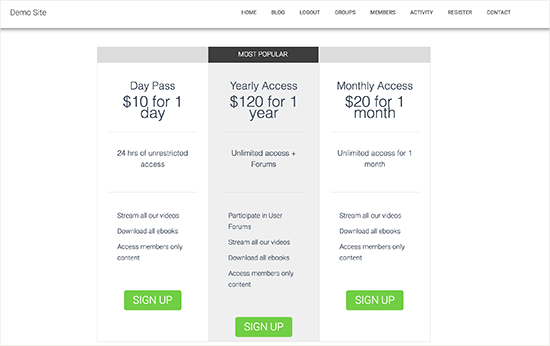
Redirecting Users to the Pricing and Plans Page
So, what happens when someone who hasn’t paid tries to access your restricted content?
Instead of just showing an error, you can automatically send them to your pricing page. This is a great way to turn a lost visitor into a new customer.
To create this redirect, go to the MemberPress » Groups page and copy the URL of the pricing page you created in the previous step.
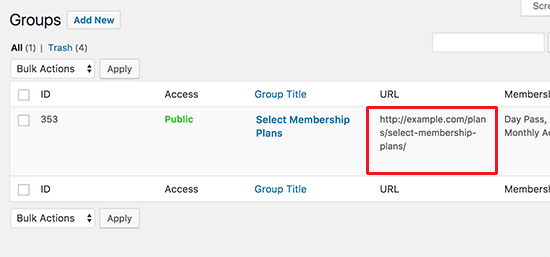
Next, head over to the MemberPress » Settings page.
Here, select the ‘Pages’ tab.

You can now scroll to the ‘Unauthorized Access’ section and check the box next to ‘Redirect unauthorized visitors to a specific URL.’
You can paste the URL into the following field: ‘URL to redirect unauthorized visitors to.’
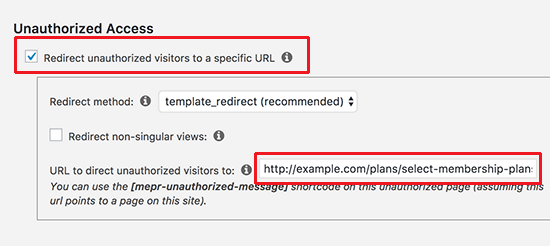
Don’t forget to click on the ‘Update Options’ button to save your changes.
Now, anyone who tries to access restricted content without a membership plan will get redirected to the pricing page.
Taking Your Pay-Per-View Website to the Next Level
MemberPress is a powerful plugin with tons of amazing features and lots of add-ons you can use to build a successful pay-per-view site.
You can also use it to create and sell online courses. This is a great choice if you have specialist knowledge or skills to share with your audience.
Another option is connecting MemberPress to an email marketing service like Constant Contact. In this way, you can keep subscribers updated on your pay-per-view content, which means they’ll be more likely to continue with their membership plan.
You can even integrate it into an existing online store using the WooCommerce addon.
For more ideas, you can see our complete MemberPress review.
Frequently Asked Questions About Pay-Per-View Websites
Here are some questions that our readers frequently ask about pay-per-view websites.
What kind of content can I sell on a pay-per-view basis?
You can sell nearly any type of digital content as pay-per-view. This includes premium videos, online courses, exclusive blog posts, eBooks, and even digital downloads like software or audio files.
Is pay-per-view the same as a subscription?
They are closely related but not exactly the same. Pay-per-view usually means a one-time payment for a single piece of content, while a subscription involves recurring payments for ongoing access.
With pay-per-view, most systems let users watch the content multiple times within a specific timeframe, such as 24 hours or a week.
A powerful plugin like MemberPress allows you to offer both models. You can sell one-off access or create daily, weekly, and monthly passes.
Can I offer a free trial for my membership plans?
Absolutely. Offering a free trial is a popular marketing strategy that lets users sample your content before committing to a purchase. MemberPress has built-in settings that allow you to easily add a free trial period to any membership level you create.
How can I market my pay-per-view content?
Promoting your content is key to getting sales. You can use email marketing to notify your audience about new content, write free blog posts to attract visitors, and promote your premium offerings on social media.
We hope this article helped you learn how to create a pay-per-view site with WordPress. For more ideas, you may also want to see examples of these membership websites or the most popular digital products you can sell online.
If you liked this article, then please subscribe to our YouTube Channel for WordPress video tutorials. You can also find us on Twitter and Facebook.


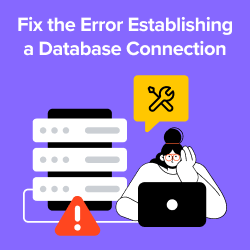


Dayo Olobayo
The world of online commerce is indeed vast. Thanks for sharing this but how can pay-per-view site owners ensure the content they’re selling remains secure and protected from piracy? Are there specific plugins or tools recommended to mitigate these risks?
WPBeginner Support
It would depend on the content type, as an example for videos there are tools to limit where the video can be viewed as an embed while images can be watermarked.
Admin
Dayo Olobayo
Thanks for this response. The video and image right protection makes sense but what about the sales of softwares? Would you happen to have a tip for protecting my work from scavengers?
WPBeginner Support
That would heavily depend on the software and how it is set up. We do not have a specific recommendation for that as it would depend on the coding.
Mrteesurez
Please, how is this pay per view really works. Is user paying to view each article on a site, i.e to views any article he has to pay for that particular article Or he will pay to view some articles for a particular period of time.
WPBeginner Support
The method in this guide shows how to limit access based on time, the danger of using the number of times a post is viewed is if a user needs to refresh their page it could count that as an additional view.
Admin
Mrteesurez
Thanks for your reply and support, If I understand your words now, you mean it’s better to set the view based on time frame rather than view count ? isn’t it ?
Jeremy Roberts
Normally yes we would recommend time instead of the number of visits.
alex magno
I tried the plugins but it is not possible to buy the single article, it is necessary to make a temporary subscription, how can this be done?
M.a. shurbaji
Can you help with pay by click plugin tutorial for classified web site. Thank you